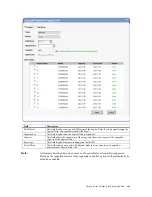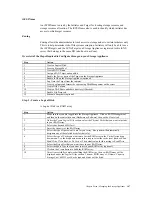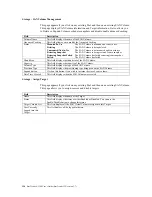
StorTrends® 1300 User’s Guide (StorTrends iTX version 2.7)
146
Storage
What is iSCSI?
iSCSI is Internet SCSI, an IP-based storage networking standard which maps SCSI
blocks into Ethernet packets, developed by the Internet Engineering Task Force (IETF).
Basically, the iSCSI protocol is a method for transporting low latency SCSI blocks across
IP networks. By carrying SCSI commands over IP networks, iSCSI is used to facilitate
data transfers over intranets and to manage storage over long distances. The iSCSI
protocol increases the capabilities and performance of storage data transmissions.
Because of the wide use of IP networks, iSCSI can be used to transmit data over LANs,
WANs, or the Internet and can enable location-independent data storage and retrieval.
SAN versus NAS
iSCSI is a Storage Area Network (SAN) technology. SAN is a block-level based storage
solution. Applications that require block-level based storage, such as Microsoft SQL
server and Microsoft Exchange server, can use a SAN device for storage.
Network Attached Storage (NAS) is a file-level based storage solution. You cannot use it
with applications that require block-level based storage.
iSCSI Network Overview
An iSCSI network can consist of the following:
•
a server with a network interface card(s) or Host Bus Adapter (HBA) with iSCSI
over TCP/IP capability, such as a server running Microsoft 2003 Server and iSNS
server.
•
a storage device with an iSCSI-enabled Ethernet connection(s), such as the
StorTrends iTX.
•
an IP switch.
•
a host computer that is running an initiator that initiates storage traffic with the target
storage device.
Note:
Some iSCSI-based networks contain iSCSI storage switches and routers. Since most
current SANs use Fibre Channel technology, multi-protocol switches (or storage routers
capable of translating iSCSI to Fibre Channel) must be used so that iSCSI connected
hosts can communicate with existing Fibre Channel devices.
Storage traffic is commonly initiated by a host computer, initiator, and received by the
target storage device. Since target devices can have multiple storage devices associated
with them (each one being a logical unit (LUN)), the final destination of the data is not
the target, but the specific LUN within the target.
Initiator
An iSCSI Initiator is a system (server, workstation, storage device, router and switch) that
starts (initiates) the transfer of information to and from an iSCSI target.
Target
An iSCSI Target (such as a volume located in the ManageTrends) is any device that
responds to and communicates with the iSCSI initiator, using the TCP/IP protocol and the
iSCSI protocol.
Summary of Contents for ManageTrends 2.7
Page 18: ...StorTrends 1300 User s Guide StorTrends iTX version 2 7 xviii...
Page 24: ...StorTrends 1300 User s Guide StorTrends iTX version 2 7 6...
Page 33: ...Chapter Two Chassis Set Up 15 Accessing the Inside of the System...
Page 60: ...StorTrends 1300 User s Guide StorTrends iTX version 2 7 42...
Page 64: ...StorTrends 1300 User s Guide StorTrends iTX version 2 7 46...
Page 70: ...StorTrends 1300 User s Guide StorTrends iTX version 2 7 52...
Page 100: ...StorTrends 1300 User s Guide StorTrends iTX version 2 7 82...
Page 106: ...StorTrends 1300 User s Guide StorTrends iTX version 2 7 88 Control Panel...
Page 236: ...StorTrends 1300 User s Guide StorTrends iTX version 2 7 218...
Page 256: ...StorTrends 1300 User s Guide StorTrends iTX version 2 7 238...
Page 277: ...Appendix E Replication Overview 259 Snap Assisted Replication Navigating with ManageTrends...
Page 281: ...Appendix E Replication Overview 263 Replication SAR view Primary Box SAR view Secondary Box...
Page 285: ...Appendix E Replication Overview 267 After Failover Operation in Secondary Box...
Page 300: ...StorTrends 1300 User s Guide StorTrends iTX version 2 7 282...
Page 308: ...StorTrends 1300 User s Guide StorTrends iTX version 2 7 290...
Page 330: ...StorTrends 1300 User s Guide StorTrends iTX version 2 7 312...
Page 356: ...StorTrends 1300 User s Guide StorTrends iTX version 2 7 338...
















































